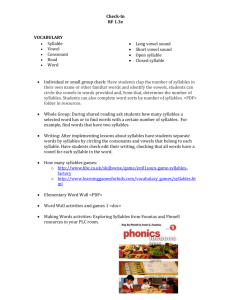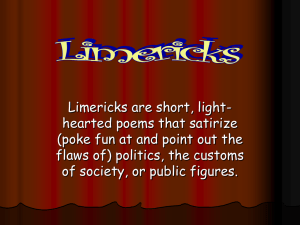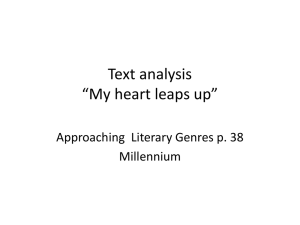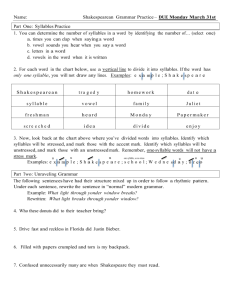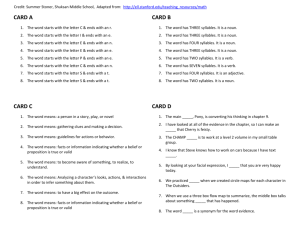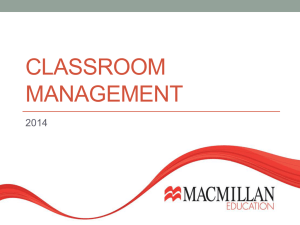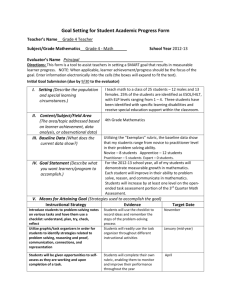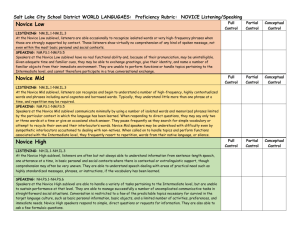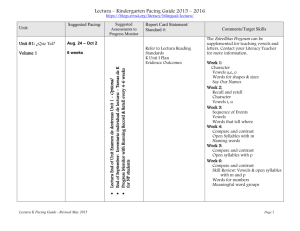Student - Language Links 2006
advertisement
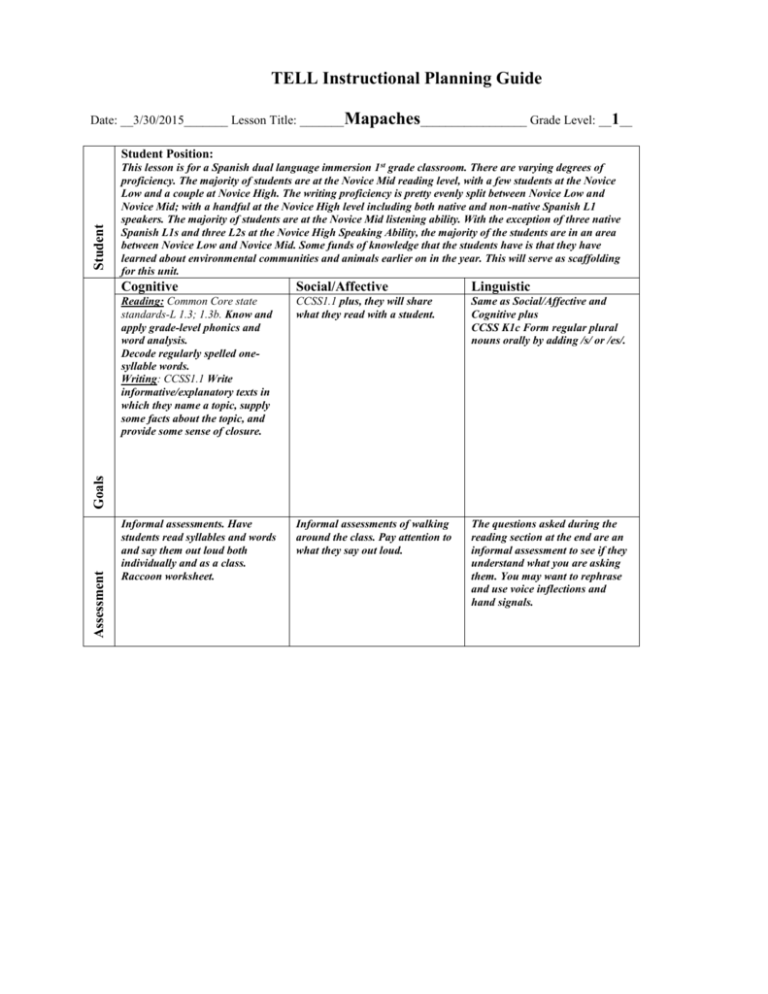
TELL Instructional Planning Guide Date: __3/30/2015_______ Lesson Title: _______ Mapaches_________________ Grade Level: __1__ This lesson is for a Spanish dual language immersion 1 st grade classroom. There are varying degrees of proficiency. The majority of students are at the Novice Mid reading level, with a few students at the Novice Low and a couple at Novice High. The writing proficiency is pretty evenly split between Novice Low and Novice Mid; with a handful at the Novice High level including both native and non-native Spanish L1 speakers. The majority of students are at the Novice Mid listening ability. With the exception of three native Spanish L1s and three L2s at the Novice High Speaking Ability, the majority of the students are in an area between Novice Low and Novice Mid. Some funds of knowledge that the students have is that they have learned about environmental communities and animals earlier on in the year. This will serve as scaffolding for this unit. Cognitive Social/Affective Linguistic Reading: Common Core state standards-L 1.3; 1.3b. Know and apply grade-level phonics and word analysis. Decode regularly spelled onesyllable words. Writing: CCSS1.1 Write informative/explanatory texts in which they name a topic, supply some facts about the topic, and provide some sense of closure. CCSS1.1 plus, they will share what they read with a student. Same as Social/Affective and Cognitive plus CCSS K1c Form regular plural nouns orally by adding /s/ or /es/. Informal assessments. Have students read syllables and words and say them out loud both individually and as a class. Raccoon worksheet. Informal assessments of walking around the class. Pay attention to what they say out loud. The questions asked during the reading section at the end are an informal assessment to see if they understand what you are asking them. You may want to rephrase and use voice inflections and hand signals. Assessment Goals Student Student Position: 1. With the students on the carpet and you the teacher at the small white board, write the unit’s objective on the board. Have the students repeat after you. “Yo puedo leer y escribir sílabas para hacer palabras y oraciones.” 2. Choose five syllable cards to go over with the class. Say “sonido” to have them just repeat the syllables you write on the board. Ex: with the word “casita”, say “sonido”, then write “ca” and draw a semi-circle underneath it which will indicate that you want the students to say the syllable out loud. Once you have gone over all three syllables with the students, say “sonido” again and have them say each syllable. Then say “palabra” and underline the whole word and they will read the word as a whole. With the five words that are on the board, count the syllables of each word with the class. Have the students clap out the syllables. “Ca”/clap, “si”/clap, “ta”/clap. “Cuántas sílabas hay?” 3. Show them 3-4 more cards and have them read the cards out loud. Tell them to first read the word in their head; second, whisper it to a partner; then, with your fingers count to three and on the count of three the students will say it out loud. 4. Instruct the students that they are to quietly return to their desks and they have 2-3 minutes to remain completely quiet. As they are at their desks remaining quiet, hand out the sheet with the picture of a raccoon in the middle. 5. Show the class that they should fold their paper to have four squares. Instruct them to fold so that the blank side is showing and not the side with the picture and written text. Give them 1-2 minutes to make their folds. 6. Clap your hands according to the amount of syllables the word has and ask the class how many syllables there are. Ex: the first word you will have them write is “negra”, so clap your hands twice and ask “Cuántas sílabas hay?” Make sure to let them know to raise their hand and to not speak the answer. Choose somebody to give you the answer. After this, draw two lines on the board and represent both syllables. Instruct them to hold up their paper when they have the word written. Depending on the difficulty and length of the word, give them 1-3 minutes to write the words. When students start raising their paper, walk around and check for accuracy and aid the students who might be struggling. Repeat this step with each word. The other words will be mapache and mediano. Sequence of Tasks 7. After you have gone over all three words with the students, show them that you want them to now open up the paper completely so that the side with the image and text is showing. With the projector, bring up the image(s) of a raccoon and ask them “Qué animal es?” and again have them raise their hand. Tell them that the title in the middle of the page will be this answer as well as question 1. After they have answered it, write the answer in the blank and show on the document camera. Ask each question to the class and have them answer the questions and fill in the blanks on their own. Either explicitly or subtly, for number 4, tell them that the answers are already on the page now for them. 8. Instruct the students to go back to the carpet. While they’re walking over, open the “Calle de la lectura” book to “La vida en el bosque”. 9. As scaffolding for the reading, go over the words on the bulletin board “Palabras de la lectura”. With the words on the left hand side, tell the students that you want to make a sign with their hands. The sign is to make a fist and then open the fist and wiggle the fingers. Materials 10. Sit down by the small whiteboard and read along with the students. On some pages, feel free to ask questions to get the students thinking such as “Is (name of animal) big? Or small? Or mi- size?”, “What is this animal?” “What does this animal eat?” and any others to get the students speaking and thinking. Small white board with marker. Cards with words split up into syllables. Large white board. Projector. Images of raccoons. Document camera. Bulletin board with Palabras de la lectura. Calle de la Lectura book. ©2003 Brigham Young University Teemant, A., Harris, M., & Pinnegar, S. (2003). Foundations of bilingual education: Instructional guide (2nd ed.). Provo, UT: Brigham Young University

